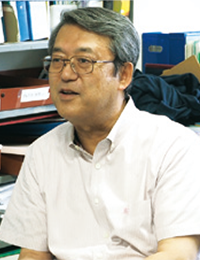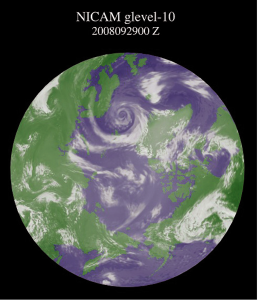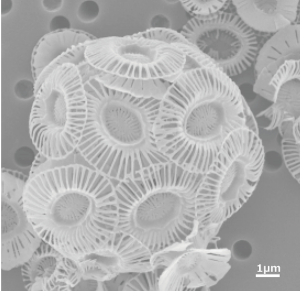キーワード: 北極圏、温暖化、海氷激減、生態系、北極振動
http://plmet.biol.tsukuba.ac.jp/
 地球温暖化によって北極の氷が溶け始めている、という話を聞いたことはありますか? 実際に、北極圏の海氷の激減によって、それまで氷で隔てられていた大西洋と太平洋の植物プランクトン種が混ざり合う現象が確認されています。また、海洋の一次生産者である植物プランクトンの種数や個体数が大きく変化し、食物連鎖系をとおして漁業資源の生産変動など人間活動にも影響が出ています。これまで、こうした多くの観測データの蓄積は膨大になっているものの、温暖化の原因や影響の解明は、まだまだ難しい問題です。
地球温暖化によって北極の氷が溶け始めている、という話を聞いたことはありますか? 実際に、北極圏の海氷の激減によって、それまで氷で隔てられていた大西洋と太平洋の植物プランクトン種が混ざり合う現象が確認されています。また、海洋の一次生産者である植物プランクトンの種数や個体数が大きく変化し、食物連鎖系をとおして漁業資源の生産変動など人間活動にも影響が出ています。これまで、こうした多くの観測データの蓄積は膨大になっているものの、温暖化の原因や影響の解明は、まだまだ難しい問題です。
本リサーチユニットでは、フィールド調査、実験室での解析、コンピューターシミュレーション等様々なアプローチを用い、北極圏における気候変動と海洋生態系変動の原因と影響を正しく把握することを目指して研究を行っています。
多角的なアプローチで北極圏の温暖化を科学する

図1:筑波大学計算科学研究センターのスーパーコンピュータT2K による全球雲解析(渦を巻いている部分が北極低気圧)
本ユニットには、3つの研究領域があります。環境変動解析領域は、北極圏の気候や海域・陸域の環境変動を解析しています。例えば、北極海の海氷が激減している理由として、海氷を砕いてしまう北極低気圧の存在が考えられていますが、その実態はよくわかっていません。そこで、スーパーコンピュータに様々な数値条件を与えて地球全体の雲や気圧の動きをシミュレーションし、実際の北極低気圧を再現することで、その構造や成因を解析しています(図1)。また、海底の堆積物の分析から過去の海洋環境を復元する共同研究を進めています。
海洋生態系変動解析領域では、海洋科学調査船によって採集された海洋植物・動物プランクトン群集の動態を解析し、温暖化がどう生態系に影響しているかを調査しています。
海洋生物環境変動影響解析領域では、白亜紀に生産された石灰岩や石油の起源となったハプト藻類円石藻(図2)を対象に、世界で唯一筑波大学が海洋研究開発機構と共同で単離に成功した北極海株の生理特性を解析しています。

図2:円石藻類の一種。
( スケールバーは 1000 分の 1mm)
円石藻と温暖化研究の深い関係
円石藻は、海洋に生息する単細胞藻類で、光合成と石灰化により大気・海洋中の二酸化炭素を固定し、海底へ輸送するポンプの役割を担っています。バイオマス*1が大きく、地球規模の炭素循環に大きな影響を及ぼす重要な生物です。この円石藻が今、北極の冷たい海で増加しています。円石藻の低温適応メカニズムや増殖特性などを解明できれば、変動する北極海における植物プランクトンの動態や生態系への影響、物質生産性を予測するために必要なパラメーターを提供することが可能になります。
こうした多角的な研究の積み重ねが、北極圏における温暖化影響解析、海洋生態系変動の未来予測には不可欠なのです。
*1:ある空間に存在する生物の量を、物質の量(質量など)で表現したもの
社会への貢献・実績
● 第2回国際アルケノン研究に関するジョイントミーティングを主催
● 北極圏温暖化影響解析に関するシンポジウム「 地球温暖化の停滞と加速」(気象学会)開催
取材:平成27年6月19日
From observation to analysis / For the next stage of research on global warming in the Arctic
Unit members : Matsuoka, Norikazu ISHIDA, Ken-ichiro Ikeda, Atsushi Nakayama, Takeshi Suzuki, Iwane
Unit name: Arctic Warming Effect
Keywords: Arctic, global warming, a sharp decrease in sea ice, ecosystems, Arctic oscillation
http://plmet.biol.tsukuba.ac.jp/index-en.html
 Have you ever heard that ice in the Arctic is melting due to global warming? In fact, studies have confirmed that phytoplankton species in the Atlantic and Pacific Oceans, which used to be separated from each other by ice, have been mixed together due to a significant decrease in the volume of Arctic sea ice, as an abnormal phenomenon. Furthermore, there have been significant changes in the numbers of phytoplankton – the primary producer, as well as its species; and the activities of humans have been influenced through the food chain system, including changes in the production of fishery resources. Although large volumes of observational data have been obtained, the causes of global warming and its influences have yet to be identified or examined.
Have you ever heard that ice in the Arctic is melting due to global warming? In fact, studies have confirmed that phytoplankton species in the Atlantic and Pacific Oceans, which used to be separated from each other by ice, have been mixed together due to a significant decrease in the volume of Arctic sea ice, as an abnormal phenomenon. Furthermore, there have been significant changes in the numbers of phytoplankton – the primary producer, as well as its species; and the activities of humans have been influenced through the food chain system, including changes in the production of fishery resources. Although large volumes of observational data have been obtained, the causes of global warming and its influences have yet to be identified or examined.
The research unit conducts research to identify the causes of climate and marine ecological changes in the Arctic and correctly understand their influences, using various approaches, such as field surveys, laboratory analyses, and computer simulations.
Multilateral scientific approaches to global warming

Figure 1: Analysis of global cloud cover using a super computer, T2K, in the Center for Computational Sciences, the University of Tsukuba
The unit consists of three research fields. The field of “analyses of environmental changes” is for the analysis of the climate of the Arctic and environmental changes in its ocean and land areas. For example, although some people suggest that the significant decrease in the volume of Arctic sea ice is caused by low-pressure systems in the Arctic, which break the ice, the details of the mechanism have yet to be examined. In the analyses of the structure of low pressures in the Arctic and the causes of their formation, the movements of clouds and atmospheric pressures around the earth are simulated by inputting numerical values to super computers as climate conditions to reproduce actual low pressure systems in the Arctic (Figure 1). Collaborative research involving analyses of sediments accumulated on the sea bottom is also conducted to restore marine environments in the past. The field of “Analyses of changes in Ocean Ecosystems” analyzes the community dynamics of marine phytoplankton and zooplankton collected by marine research vessels, and examines the effects of global warming on ecosystems.
The field of “Analyses of Changes in Environments for Marine Organisms” conducts research on haptophyta (Figure 2), a type of coccolithophore, which are the origins of limestones and petroleum generated in the Cretaceous period, and analyzes the physiological properties of the strains of haptophyta living in the Arctic; the University of Tsukuba is the only institution in the world that accomplished their isolation in collaboration with the Japan Agency for Marine Earth Science and Technology.

Figure 2: A type of coccolithophore (1/1,000-mm scale bar)
Close relationship between coccolithophore and research on global warming
Coccolithophore, a single-celled alga living in the sea, fixes carbon dioxide that is present in the sea and atmosphere through photosynthesis and calcification, and serves as a pump to transport it to the bottom of the sea. Coccolithophore is a valuable organism in that it has a large biomass*1 and significantly influences the global carbon cycle. There has been an increase in the number of coccolithophore in the cold sea of the Arctic. Parameters required for predicting the dynamics of phytoplankton, its influences on ecosystems, and material productivity in the Arctic sea, which is in a fluctuating environment, can be provided by clarifying the mechanism of coccolithophore to adapt itself to low temperatures and the characteristics of its proliferation.
For the analysis of the influences of global warming and the prediction of changes in marine ecosystems in the Arctic, it is essential to continue multilateral research.
*1: The amount of organisms in a space expressed as the mass of matter
Social contributions and achievements
– The 2nd International Joint Meeting of the Alkenone Biosynthesis and Geoscience
– Symposium “Stagnation and Acceleration of Global Warming” for the analysis of the effects of global warming in the Arctic (The Meteorological Society of Japan)
Interviewed on June 19, 2015
